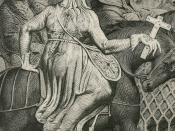Modes Used in the Pardoner's Tale
The Pardoner's presentation to the congregation in Chaucer's Canterbury tales is written in both the expository mode as well as the satiric mode. Other modes can also be found in this story such as irony. It is a mode that is indirectly connected to the satiric and expository modes.
To understand how the Pardoner's presentation is presented in expository mode we must first know what expository mode is meant to achieve. Expository mode is used to get a certain point or a moral across to the audience, which in this case would be the congregation that is presented to, by the Pardoner. The Pardoner starts his presentation off by explaining how greed is an evil sin of which even he can be accused. Though he admits to his own greed, he explains that from his own sins he can prevent others from doing the same.
The Pardoner's entire presentation is a sermon on the evils of greed. Since he already has given some factual truth about his own greed he uses his tale to illustrate his points further. The moral is the final objective for his story and so the sermon fits into the expository mode criteria. This is an example of the expository mode; the Pardoner has laid down a few points of truth that make up the moral of the story.
The Pardoner's tale is also satiric. The story is presented in Juvenalian satire, which is used to express indignation at man's corruption. The Pardoner shows satire when he, himself, is indignant at the corrupt characters in his tale. By expressing the indignation of corruptness by a corrupt character, (the Pardoner), Chaucer causes the reader to have even more indignation. The satire is felt even deeper.
After wrapping his story up,


